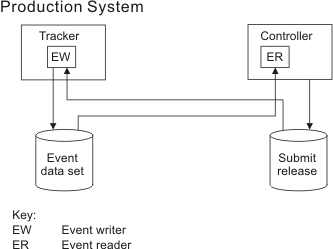DASD connected
A z/OS system connected through shared DASD shows two HCL Workload Automation for Z address spaces with a DASD connection on a z/OS system.
- Submits JCL for batch jobs to the JES internal reader
- Writes the JCL for started tasks into the EQQSTC data set and
issues
START procnamez/OS commands - Issues JES release commands for jobs in HOLD status
- Submits the cleanup job.
The event-tracking routines create event records to describe activities that occur on the system. These records are added to the tracker event writer queue in ECSA. The tracker processes the queue and writes the events into the event data set. An event-reader subtask started in the controller address space reads the event data set, and the current plan is updated.

You can also configure this system without a submit/release data set. When the workstations destination is blank; batch jobs, started tasks, release commands, and WTO messages, are processed by the submit subtask automatically started in the controller address space. The event-tracking process remains unchanged.
| Members for the controller | Members for the tracker |
|---|---|
|
OPCECNT
|
TRKA
|
|
STDERDR
|
STDEWTR
|